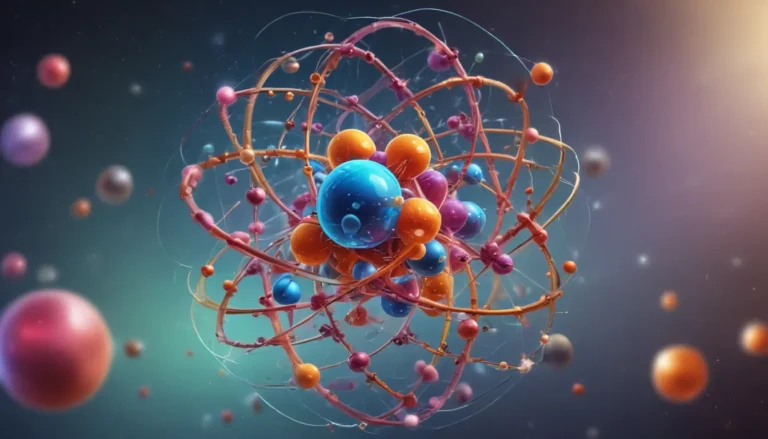A Note About Images: The images used in our articles are for illustration purposes only and may not exactly match the content. They are meant to engage readers, but the text should be relied upon for accurate information.
Are you ready to delve into the fascinating realm of quantum numbers? Imagine them as unique ID cards for electrons, revealing their energy levels, orbital shapes, orientations, and spins. These essential identifiers play a pivotal role in shaping the behavior of atoms in chemical reactions and defining the properties of elements. Let’s embark on a journey to uncover the hidden intricacies of quantum numbers and their profound impact on physics, chemistry, and technology.
Demystifying Quantum Numbers
Quantum numbers, comprising a set of four values, serve as the distinctive characteristics that define an electron within an atom. These numbers govern crucial aspects such as the electron’s energy, orbital shape, orientation, and spin, offering a glimpse into the microcosm of atomic structure.
Unveiling the Principal Quantum Number
The principal quantum number, symbolized by “n,” serves as the beacon that illuminates the energy level or shell where an electron resides. As the principal quantum number ascends, reaching higher values, electrons soar to elevated energy levels, venturing farther away from the nucleus in their orbital dance.
Deciphering the Azimuthal Quantum Number
Dancing on the orbital stage, the azimuthal quantum number, denoted by “l,” takes center stage in shaping the contours of electrons’ orbits. Ranging from 0 to (n-1), this number dictates the orbital’s shape, unveiling the intricate subshells like s, p, d, and f that underpin the electron’s movements.
Navigating the Magnetic Quantum Number
Within the vast expanse of space, the magnetic quantum number, labeled as “ml,” acts as the compass guiding the orientation of an orbital within a subshell. This magnetic navigator adopts integer values fluctuating from -l to +l, paving the way for electrons to find their designated path.
Embracing the Spin Quantum Number
In the realm of intrinsic properties, the spin quantum number, denoted by “ms,” unveils the mesmerizing spin of electrons. With values of +1/2 or -1/2 signifying spin-up or spin-down orientations, this number adds an exhilarating twist to the electron’s cosmic ballet.
Crafting a Symphony of Quantum Rules
The orchestration of quantum numbers adheres to a symphony of rules and restrictions, embodying the essence of the Pauli exclusion principle. This principle dictates that no two electrons within an atom can possess the same set of four quantum numbers, preserving the intricate harmony of atomic structure.
Unleashing Quantum Numbers in Elemental Configurations
Embarking on the configuration journey, quantum numbers meticulously sculpt the arrangement of electrons within an atom’s orbitals, unfolding the enigmatic electron configuration. This blueprint forms the foundation for unraveling the properties and behaviors of elements, offering a key to unlocking the mysteries of the periodic table.
Pioneering Quantum Numbers in Chemical Predictions
Empowered by the wisdom of quantum numbers, scientists harness their predictive prowess in decoding the dance of atoms during chemical reactions. By unraveling the quantum numbers of electrons at play, researchers pave the path for groundbreaking advancements in diverse realms, from pharmaceuticals to materials science.
Illuminating Spectroscopic Insights with Quantum Numbers
In the luminous realm of spectroscopy, where light interfaces with matter, quantum numbers emerge as guiding stars illuminating the energy levels and transitions of electrons. This celestial dance sheds light on the composition and structure of atoms, offering profound insights into the fabric of the universe.
Quantum Numbers: Architects of Atomic Revelations
At the heart of atomic revelations stands the discovery of quantum numbers, a revolutionary milestone in our understanding of atomic structure. Spearheaded by visionaries like Max Planck and Erwin Schrödinger, the advent of quantum mechanics propelled us into a new era of scientific enlightenment, reshaping the contours of physics and chemistry.
Quantum Numbers: Catalysts for Technological Marvels
Beyond theoretical realms, quantum numbers find a tangible foothold in cutting-edge technologies. From semiconductor devices to lasers and magnetic resonance imaging (MRI), quantum numbers serve as the guiding compass, elucidating the behavior of electrons critical to the functioning of these technological marvels.
Quantum Numbers: Leading the Quantum Computing Revolution
In the burgeoning landscape of quantum computing, quantum numbers emerge as the linchpin for steering and controlling quantum bits or qubits, the building blocks of quantum computers. Promising unparalleled computational power, these quantum numbers usher in a new era of technological innovation.
Conclusion: Embracing the Enigma of Quantum Numbers
As we conclude our exploration of quantum numbers, we unveil a realm of profound significance in understanding the behavior of electrons within atoms. These enigmatic identifiers delineate the energy levels, shapes, orientations, and spins of electrons, unveiling the intricate tapestry of atomic structure. Embark on this fascinating journey through the quantum realm and deepen your appreciation for the complexity and beauty of the universe.
Frequently Asked Questions
Q: What are quantum numbers?
Quantum numbers are a set of values used to describe the properties of electrons in an atom, unveiling their energy levels, orbital shapes, and orientations within the atomic framework.
Q: How many quantum numbers exist?
There are four quantum numbers: the principal quantum number (n), the azimuthal quantum number (l), the magnetic quantum number (m), and the spin quantum number (s), each offering a unique insight into the electron’s identity.
Q: What role does the principal quantum number play?
The principal quantum number (n) serves as the harbinger of an electron’s energy level, delineating the size of the orbital it inhabits as it traverses the atomic landscape.
Q: How does the azimuthal quantum number influence orbital shapes?
The azimuthal quantum number (l) dictates the shapes of electron orbits, unfolding a diverse array of subshells ranging from s, p, d, to f, shaping the orbital geometry.
Q: What insights does the magnetic quantum number provide?
The magnetic quantum number (m) acts as the guide, indicating the orientation of an orbital in space, portraying a vivid picture of the electron’s orbital path within the atomic domain.
Q: What significance does the spin quantum number hold?
The spin quantum number (s) delves into the intrinsic spin of electrons, unveiling the mesmerizing dance of spin-up or spin-down orientations that define the electron’s cosmic choreography.
Q: How do quantum numbers aid in elucidating electron behavior?
Quantum numbers serve as the guiding compass, offering insights into the location, energy, and orientation of electrons within an atom, enabling predictions about chemical reactions, bonding, and material properties.
Embark on a Journey of Discovery
We invite you to embark on a journey of discovery through the enigmatic world of quantum numbers, where each quantum number unveils a unique facet of the electron’s identity within an atom. From energy levels to orbital shapes, orientations, and spins, quantum numbers serve as the guiding stars illuminating the cosmic symphony of atomic structure. Embrace the beauty and complexity of quantum mechanics as you unlock the secrets of the microscopic world.






